Financial Audit Risk Assessment: National Australia Bank (NAB)
VerifiedAdded on 2022/12/20
|6
|1099
|1
Report
AI Summary
This report provides an audit risk assessment of National Australia Bank (NAB), analyzing its 2018 annual report. It identifies three accounts at significant risk: Goodwill, Fair Value of Financial Instruments, and Accounting for Discontinued Operations. The analysis highlights the key judgments and es...

Running head: AUDITING AND ASSURANCE
Auditing and Assurance
Name of the Student
Name of the University
Author’s Note
Auditing and Assurance
Name of the Student
Name of the University
Author’s Note
Paraphrase This Document
Need a fresh take? Get an instant paraphrase of this document with our AI Paraphraser
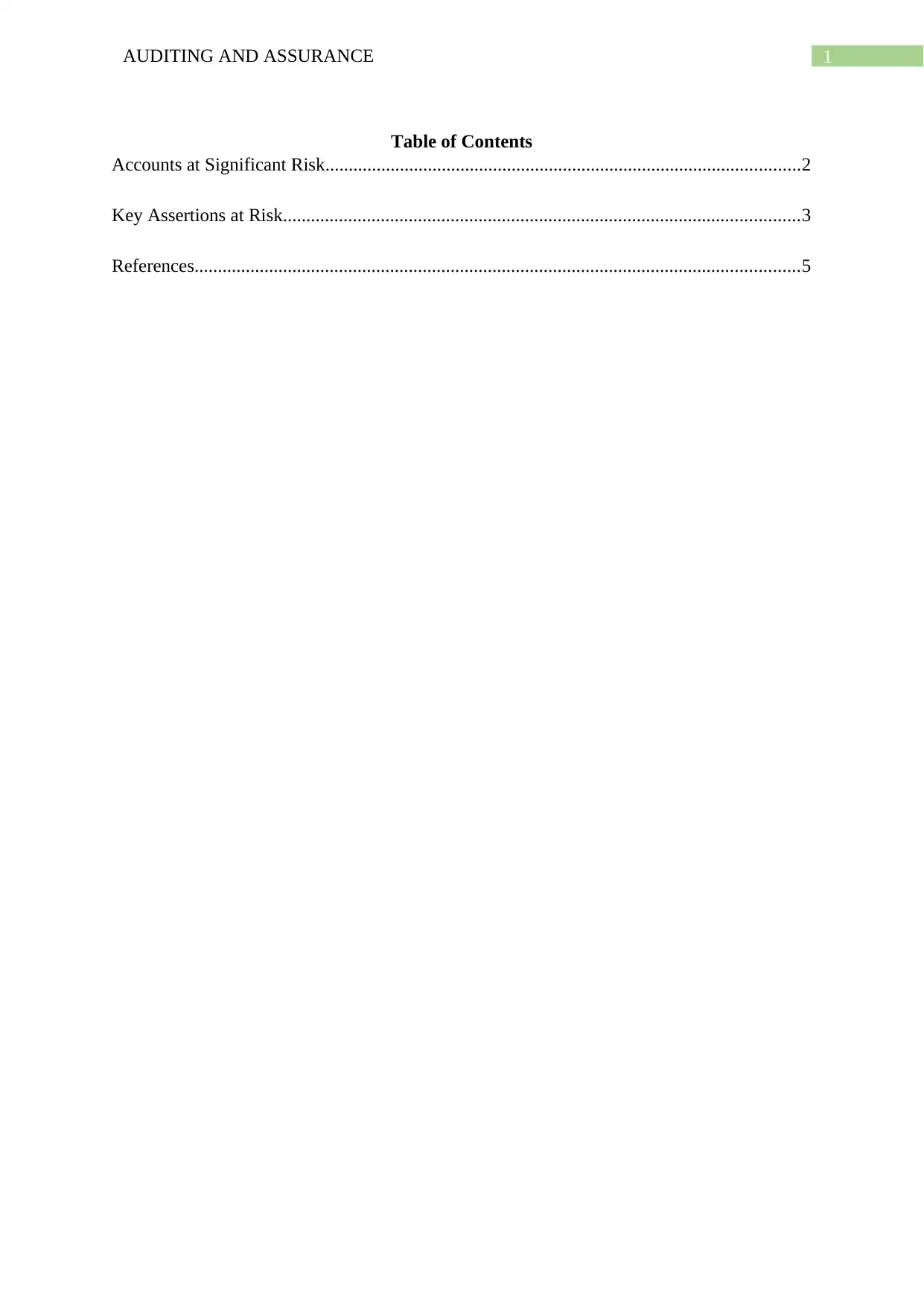
1AUDITING AND ASSURANCE
Table of Contents
Accounts at Significant Risk......................................................................................................2
Key Assertions at Risk...............................................................................................................3
References..................................................................................................................................5
Table of Contents
Accounts at Significant Risk......................................................................................................2
Key Assertions at Risk...............................................................................................................3
References..................................................................................................................................5
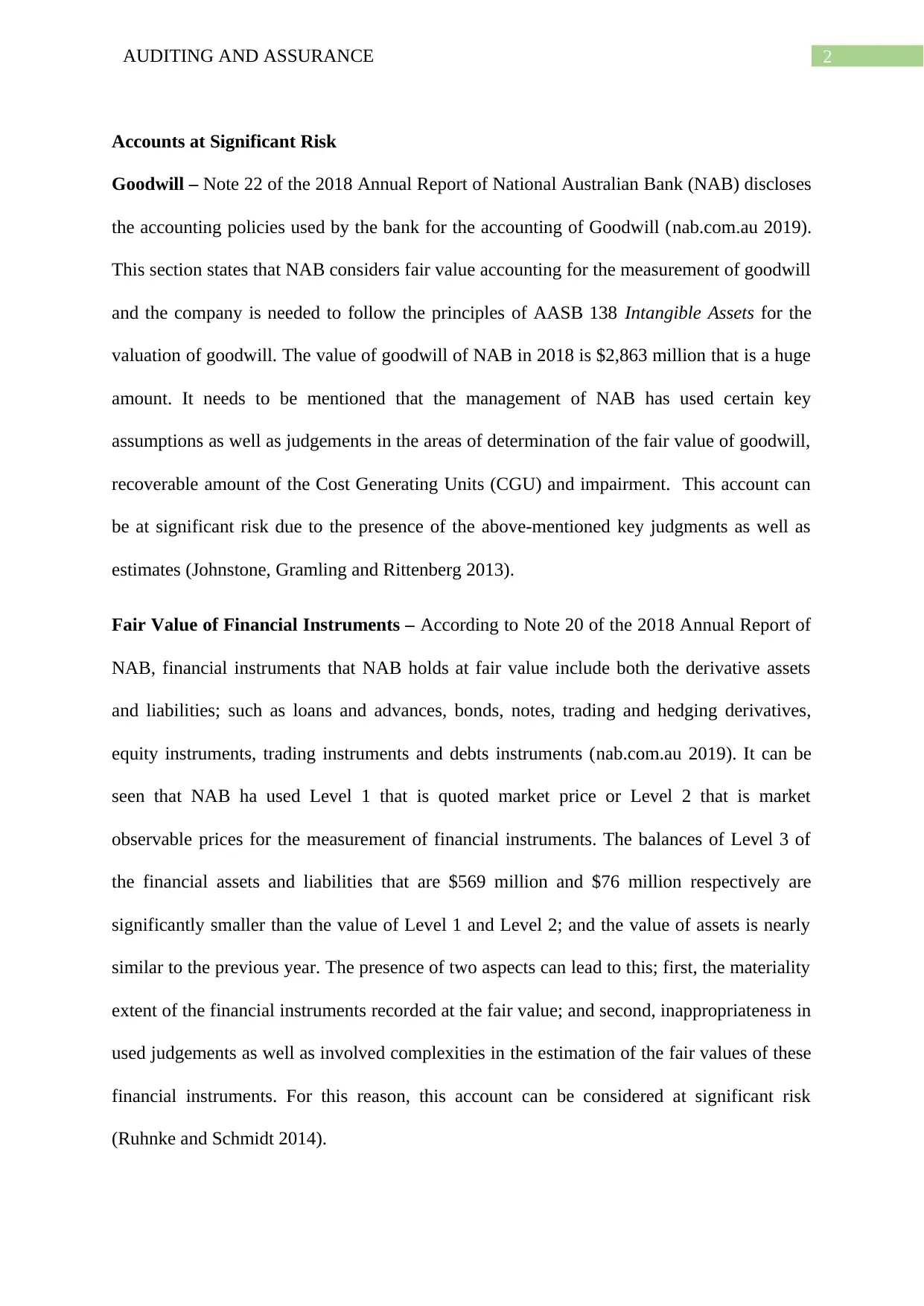
2AUDITING AND ASSURANCE
Accounts at Significant Risk
Goodwill – Note 22 of the 2018 Annual Report of National Australian Bank (NAB) discloses
the accounting policies used by the bank for the accounting of Goodwill (nab.com.au 2019).
This section states that NAB considers fair value accounting for the measurement of goodwill
and the company is needed to follow the principles of AASB 138 Intangible Assets for the
valuation of goodwill. The value of goodwill of NAB in 2018 is $2,863 million that is a huge
amount. It needs to be mentioned that the management of NAB has used certain key
assumptions as well as judgements in the areas of determination of the fair value of goodwill,
recoverable amount of the Cost Generating Units (CGU) and impairment. This account can
be at significant risk due to the presence of the above-mentioned key judgments as well as
estimates (Johnstone, Gramling and Rittenberg 2013).
Fair Value of Financial Instruments – According to Note 20 of the 2018 Annual Report of
NAB, financial instruments that NAB holds at fair value include both the derivative assets
and liabilities; such as loans and advances, bonds, notes, trading and hedging derivatives,
equity instruments, trading instruments and debts instruments (nab.com.au 2019). It can be
seen that NAB ha used Level 1 that is quoted market price or Level 2 that is market
observable prices for the measurement of financial instruments. The balances of Level 3 of
the financial assets and liabilities that are $569 million and $76 million respectively are
significantly smaller than the value of Level 1 and Level 2; and the value of assets is nearly
similar to the previous year. The presence of two aspects can lead to this; first, the materiality
extent of the financial instruments recorded at the fair value; and second, inappropriateness in
used judgements as well as involved complexities in the estimation of the fair values of these
financial instruments. For this reason, this account can be considered at significant risk
(Ruhnke and Schmidt 2014).
Accounts at Significant Risk
Goodwill – Note 22 of the 2018 Annual Report of National Australian Bank (NAB) discloses
the accounting policies used by the bank for the accounting of Goodwill (nab.com.au 2019).
This section states that NAB considers fair value accounting for the measurement of goodwill
and the company is needed to follow the principles of AASB 138 Intangible Assets for the
valuation of goodwill. The value of goodwill of NAB in 2018 is $2,863 million that is a huge
amount. It needs to be mentioned that the management of NAB has used certain key
assumptions as well as judgements in the areas of determination of the fair value of goodwill,
recoverable amount of the Cost Generating Units (CGU) and impairment. This account can
be at significant risk due to the presence of the above-mentioned key judgments as well as
estimates (Johnstone, Gramling and Rittenberg 2013).
Fair Value of Financial Instruments – According to Note 20 of the 2018 Annual Report of
NAB, financial instruments that NAB holds at fair value include both the derivative assets
and liabilities; such as loans and advances, bonds, notes, trading and hedging derivatives,
equity instruments, trading instruments and debts instruments (nab.com.au 2019). It can be
seen that NAB ha used Level 1 that is quoted market price or Level 2 that is market
observable prices for the measurement of financial instruments. The balances of Level 3 of
the financial assets and liabilities that are $569 million and $76 million respectively are
significantly smaller than the value of Level 1 and Level 2; and the value of assets is nearly
similar to the previous year. The presence of two aspects can lead to this; first, the materiality
extent of the financial instruments recorded at the fair value; and second, inappropriateness in
used judgements as well as involved complexities in the estimation of the fair values of these
financial instruments. For this reason, this account can be considered at significant risk
(Ruhnke and Schmidt 2014).
⊘ This is a preview!⊘
Do you want full access?
Subscribe today to unlock all pages.

Trusted by 1+ million students worldwide
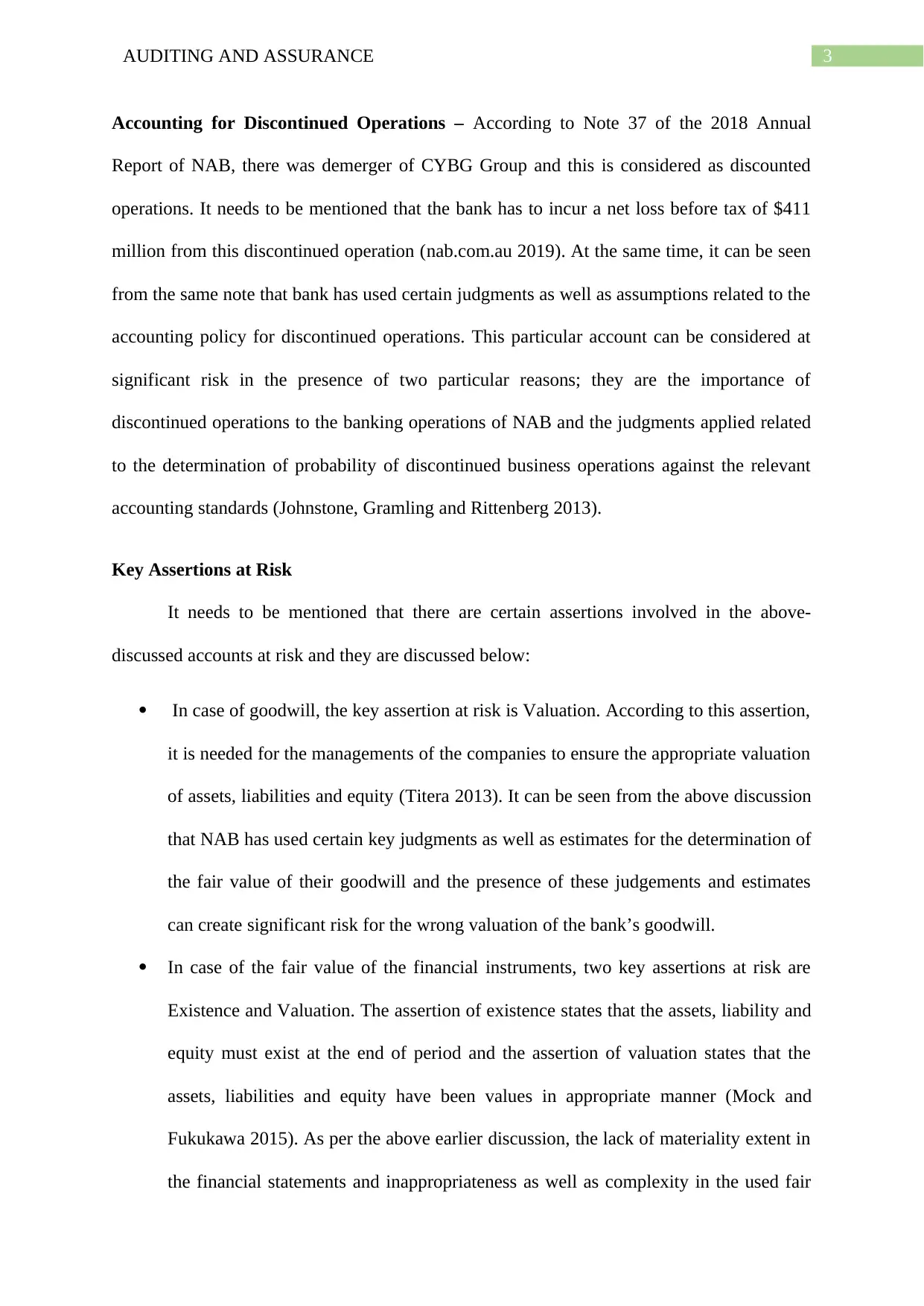
3AUDITING AND ASSURANCE
Accounting for Discontinued Operations – According to Note 37 of the 2018 Annual
Report of NAB, there was demerger of CYBG Group and this is considered as discounted
operations. It needs to be mentioned that the bank has to incur a net loss before tax of $411
million from this discontinued operation (nab.com.au 2019). At the same time, it can be seen
from the same note that bank has used certain judgments as well as assumptions related to the
accounting policy for discontinued operations. This particular account can be considered at
significant risk in the presence of two particular reasons; they are the importance of
discontinued operations to the banking operations of NAB and the judgments applied related
to the determination of probability of discontinued business operations against the relevant
accounting standards (Johnstone, Gramling and Rittenberg 2013).
Key Assertions at Risk
It needs to be mentioned that there are certain assertions involved in the above-
discussed accounts at risk and they are discussed below:
In case of goodwill, the key assertion at risk is Valuation. According to this assertion,
it is needed for the managements of the companies to ensure the appropriate valuation
of assets, liabilities and equity (Titera 2013). It can be seen from the above discussion
that NAB has used certain key judgments as well as estimates for the determination of
the fair value of their goodwill and the presence of these judgements and estimates
can create significant risk for the wrong valuation of the bank’s goodwill.
In case of the fair value of the financial instruments, two key assertions at risk are
Existence and Valuation. The assertion of existence states that the assets, liability and
equity must exist at the end of period and the assertion of valuation states that the
assets, liabilities and equity have been values in appropriate manner (Mock and
Fukukawa 2015). As per the above earlier discussion, the lack of materiality extent in
the financial statements and inappropriateness as well as complexity in the used fair
Accounting for Discontinued Operations – According to Note 37 of the 2018 Annual
Report of NAB, there was demerger of CYBG Group and this is considered as discounted
operations. It needs to be mentioned that the bank has to incur a net loss before tax of $411
million from this discontinued operation (nab.com.au 2019). At the same time, it can be seen
from the same note that bank has used certain judgments as well as assumptions related to the
accounting policy for discontinued operations. This particular account can be considered at
significant risk in the presence of two particular reasons; they are the importance of
discontinued operations to the banking operations of NAB and the judgments applied related
to the determination of probability of discontinued business operations against the relevant
accounting standards (Johnstone, Gramling and Rittenberg 2013).
Key Assertions at Risk
It needs to be mentioned that there are certain assertions involved in the above-
discussed accounts at risk and they are discussed below:
In case of goodwill, the key assertion at risk is Valuation. According to this assertion,
it is needed for the managements of the companies to ensure the appropriate valuation
of assets, liabilities and equity (Titera 2013). It can be seen from the above discussion
that NAB has used certain key judgments as well as estimates for the determination of
the fair value of their goodwill and the presence of these judgements and estimates
can create significant risk for the wrong valuation of the bank’s goodwill.
In case of the fair value of the financial instruments, two key assertions at risk are
Existence and Valuation. The assertion of existence states that the assets, liability and
equity must exist at the end of period and the assertion of valuation states that the
assets, liabilities and equity have been values in appropriate manner (Mock and
Fukukawa 2015). As per the above earlier discussion, the lack of materiality extent in
the financial statements and inappropriateness as well as complexity in the used fair
Paraphrase This Document
Need a fresh take? Get an instant paraphrase of this document with our AI Paraphraser
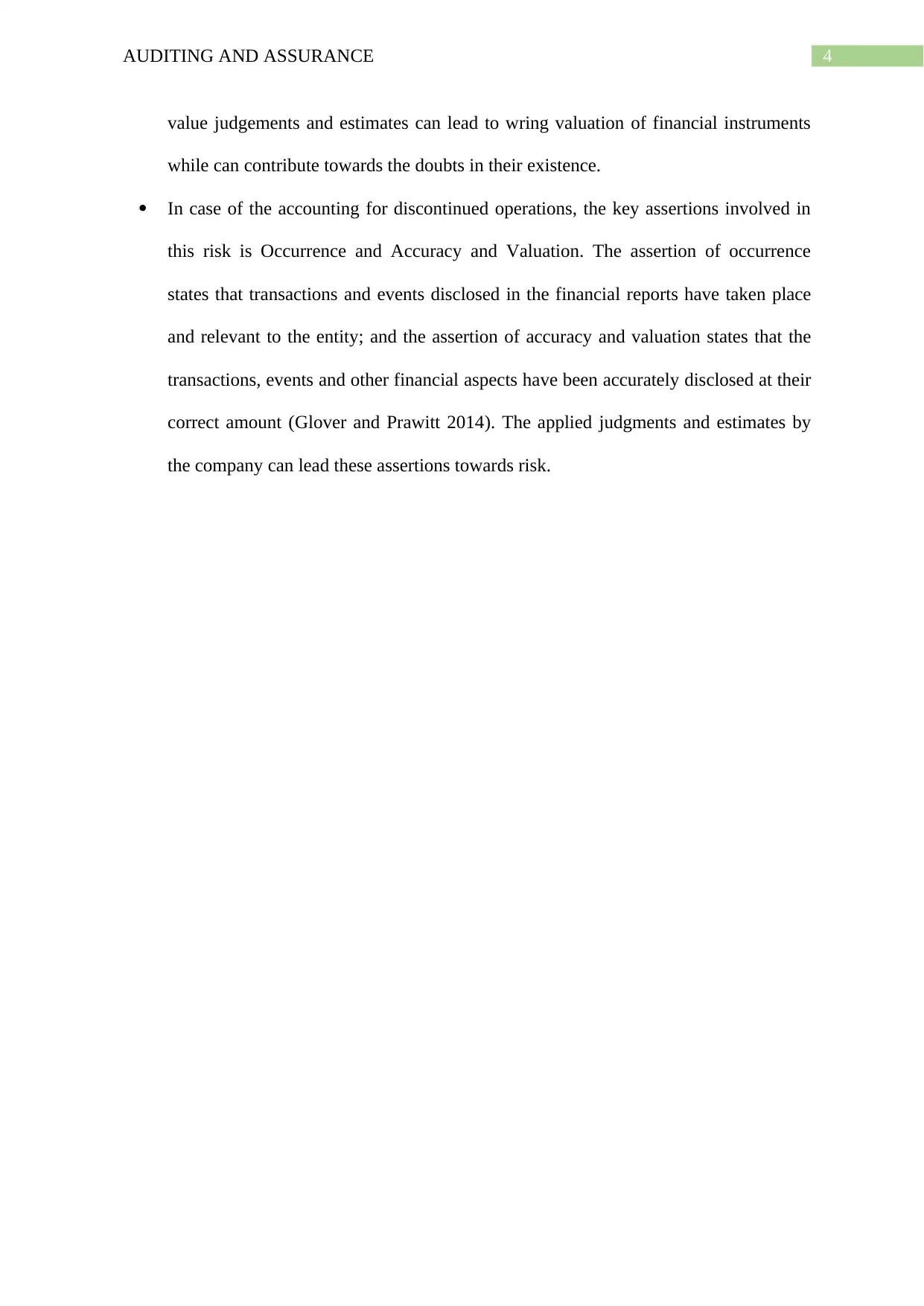
4AUDITING AND ASSURANCE
value judgements and estimates can lead to wring valuation of financial instruments
while can contribute towards the doubts in their existence.
In case of the accounting for discontinued operations, the key assertions involved in
this risk is Occurrence and Accuracy and Valuation. The assertion of occurrence
states that transactions and events disclosed in the financial reports have taken place
and relevant to the entity; and the assertion of accuracy and valuation states that the
transactions, events and other financial aspects have been accurately disclosed at their
correct amount (Glover and Prawitt 2014). The applied judgments and estimates by
the company can lead these assertions towards risk.
value judgements and estimates can lead to wring valuation of financial instruments
while can contribute towards the doubts in their existence.
In case of the accounting for discontinued operations, the key assertions involved in
this risk is Occurrence and Accuracy and Valuation. The assertion of occurrence
states that transactions and events disclosed in the financial reports have taken place
and relevant to the entity; and the assertion of accuracy and valuation states that the
transactions, events and other financial aspects have been accurately disclosed at their
correct amount (Glover and Prawitt 2014). The applied judgments and estimates by
the company can lead these assertions towards risk.
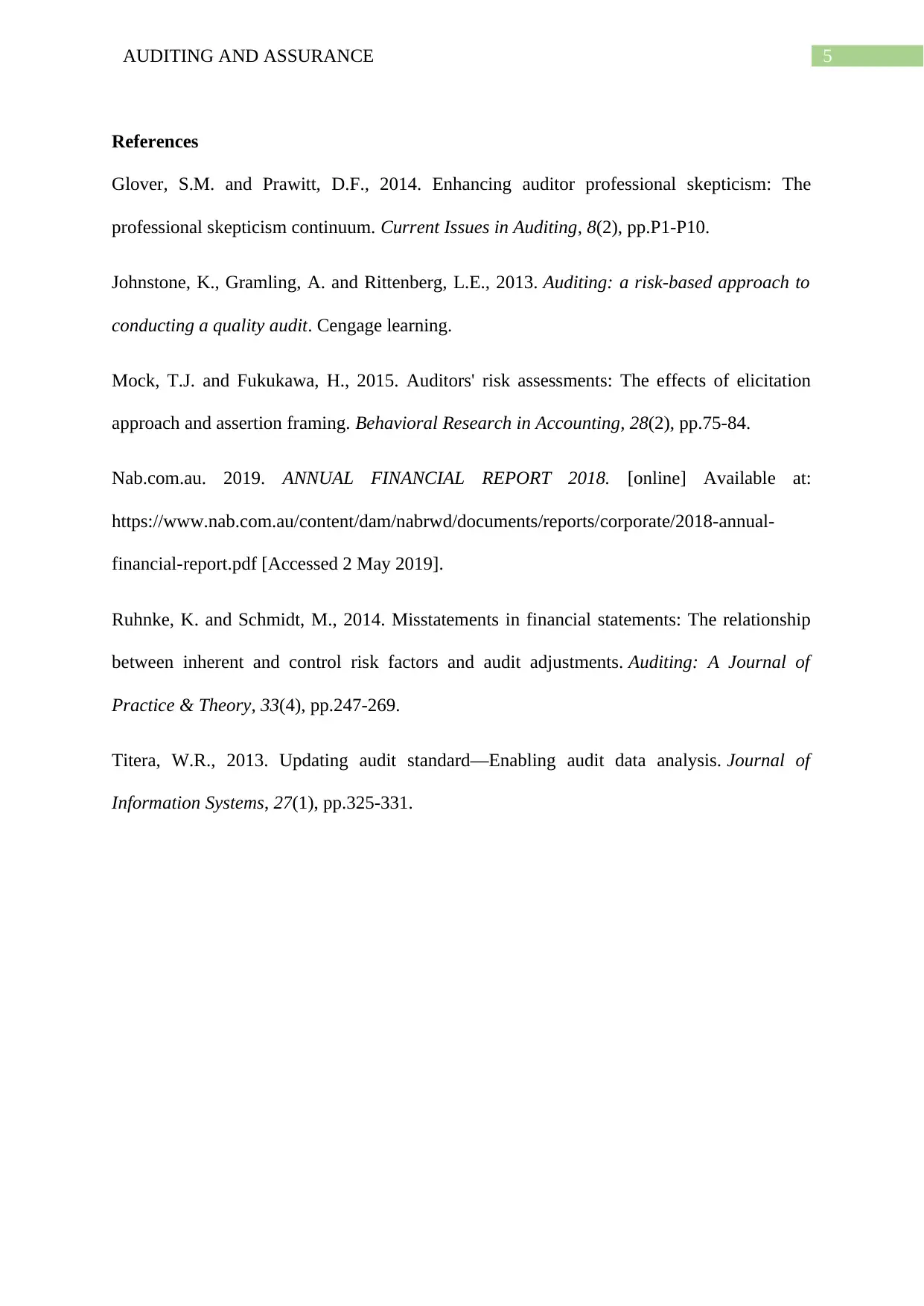
5AUDITING AND ASSURANCE
References
Glover, S.M. and Prawitt, D.F., 2014. Enhancing auditor professional skepticism: The
professional skepticism continuum. Current Issues in Auditing, 8(2), pp.P1-P10.
Johnstone, K., Gramling, A. and Rittenberg, L.E., 2013. Auditing: a risk-based approach to
conducting a quality audit. Cengage learning.
Mock, T.J. and Fukukawa, H., 2015. Auditors' risk assessments: The effects of elicitation
approach and assertion framing. Behavioral Research in Accounting, 28(2), pp.75-84.
Nab.com.au. 2019. ANNUAL FINANCIAL REPORT 2018. [online] Available at:
https://www.nab.com.au/content/dam/nabrwd/documents/reports/corporate/2018-annual-
financial-report.pdf [Accessed 2 May 2019].
Ruhnke, K. and Schmidt, M., 2014. Misstatements in financial statements: The relationship
between inherent and control risk factors and audit adjustments. Auditing: A Journal of
Practice & Theory, 33(4), pp.247-269.
Titera, W.R., 2013. Updating audit standard—Enabling audit data analysis. Journal of
Information Systems, 27(1), pp.325-331.
References
Glover, S.M. and Prawitt, D.F., 2014. Enhancing auditor professional skepticism: The
professional skepticism continuum. Current Issues in Auditing, 8(2), pp.P1-P10.
Johnstone, K., Gramling, A. and Rittenberg, L.E., 2013. Auditing: a risk-based approach to
conducting a quality audit. Cengage learning.
Mock, T.J. and Fukukawa, H., 2015. Auditors' risk assessments: The effects of elicitation
approach and assertion framing. Behavioral Research in Accounting, 28(2), pp.75-84.
Nab.com.au. 2019. ANNUAL FINANCIAL REPORT 2018. [online] Available at:
https://www.nab.com.au/content/dam/nabrwd/documents/reports/corporate/2018-annual-
financial-report.pdf [Accessed 2 May 2019].
Ruhnke, K. and Schmidt, M., 2014. Misstatements in financial statements: The relationship
between inherent and control risk factors and audit adjustments. Auditing: A Journal of
Practice & Theory, 33(4), pp.247-269.
Titera, W.R., 2013. Updating audit standard—Enabling audit data analysis. Journal of
Information Systems, 27(1), pp.325-331.
⊘ This is a preview!⊘
Do you want full access?
Subscribe today to unlock all pages.

Trusted by 1+ million students worldwide
1 out of 6
Related Documents
Your All-in-One AI-Powered Toolkit for Academic Success.
+13062052269
info@desklib.com
Available 24*7 on WhatsApp / Email
![[object Object]](/_next/static/media/star-bottom.7253800d.svg)
Unlock your academic potential
© 2024 | Zucol Services PVT LTD | All rights reserved.





